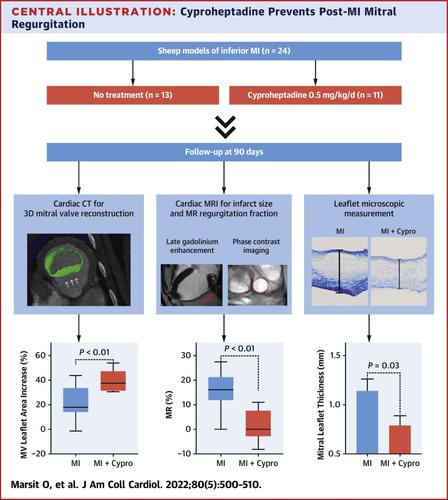Journal of the American College of Cardiology ( IF 21.7 ) Pub Date : 2022-07-25 , DOI: 10.1016/j.jacc.2022.05.025 Ons Marsit 1 , Marie-Annick Clavel 1 , Amélie Paquin 1 , Valérie Deschênes 1 , Sandra Hadjadj 1 , Isabelle Sénéchal-Dumais 1 , Jacques Couet 1 , Marie Arsenault 1 , Mark D Handschumacher 2 , Robert A Levine 2 , Elena Aikawa 3 , Philippe Pibarot 1 , Jonathan Beaudoin 1

|
Background
Ischemic mitral regurgitation (MR) is primarily caused by left ventricle deformation, but leaflet thickening with fibrotic changes are also observed in the valve. Increased levels of 5-hydroxytryptamine (5-HT; ie, serotonin) are described after myocardial infarction (MI); 5-HT can induce valve fibrosis through the 5-HT type 2B receptor (5-HT2BR).
Objectives
This study aims to test the hypothesis that post-MI treatment with cyproheptadine (5-HT2BR antagonist) can prevent ischemic MR by reducing the effect of serotonin on mitral biology.
Methods
Thirty-six sheep were divided into 2 groups: inferior MI and inferior MI treated with cyproheptadine (0.5 mg/kg/d). Animals were followed for 90 days. Blood 5-HT, infarct size, left ventricular volume and function, MR fraction and mitral leaflet size were assessed. In a complementary in vitro study, valvular interstitial cells were exposed to pre-MI and post-MI serum collected from the experimental animals.
Results
Increased 5-HT levels were observed after MI in nontreated animals, but not in the group treated with cyproheptadine. Infarct size was similar in both groups (11 ± 3 g vs 9 ± 5 g; P = 0.414). At 90 days, MR fraction was 16% ± 7% in the MI group vs 2% ± 6% in the cyproheptadine group (P = 0.0001). The increase in leaflet size following MI was larger in the cyproheptadine group (+40% ± 9% vs +22% ± 12%; P = 0.001). Mitral interstitial cells overexpressed extracellular matrix genes when treated with post-MI serum, but not when exposed to post-MI serum collected from treated animals.
Conclusions
Cyproheptadine given after inferior MI reduces post-MI 5-HT levels, prevents valvular fibrotic remodeling, is associated with larger increase in mitral valve size and less MR.
中文翻译:

赛庚啶对心肌梗死后二尖瓣重构及返流的影响
背景
缺血性二尖瓣反流(MR) 主要由左心室变形引起,但在瓣膜中也观察到小叶增厚伴纤维化变化。心肌梗塞 (MI) 后描述了 5-羟色胺(5-HT;即血清素)水平升高;5-HT可通过5-HT 2B型受体(5-HT2BR)诱导瓣膜纤维化。
目标
本研究旨在检验 MI 后用赛庚啶(5-HT2BR 拮抗剂)治疗可以通过降低血清素对二尖瓣生物学的影响来预防缺血性 MR 的假设。
方法
将 36 只绵羊分为 2 组:劣质 MI和用赛庚啶 (0.5 mg/kg/d) 处理的劣质 MI。跟踪动物 90 天。评估血液 5-HT、梗塞面积、左心室体积和功能、MR 分数和二尖瓣小叶大小。在补充体外研究中,瓣膜间质细胞暴露于从实验动物收集的 MI 前和 MI 后血清。
结果
在未治疗的动物中观察到 MI 后 5-HT 水平升高,但在用赛庚啶治疗的组中没有观察到。两组的梗死面积相似(11 ± 3 g 对比 9 ± 5 g;P = 0.414)。在 90 天时,MI 组的 MR 分数为 16% ± 7%,而赛庚啶组为 2% ± 6% ( P = 0.0001)。赛庚啶组 MI 后小叶大小的增加更大(+40% ± 9% 对比 +22% ± 12%;P = 0.001)。当用 MI 后血清处理时,二尖瓣间质细胞过度表达细胞外基质基因,但当暴露于从治疗动物收集的 MI 后血清时则不会。
结论
下壁 MI 后给予赛庚啶可降低 MI 后 5-HT 水平,防止瓣膜纤维化重塑,与二尖瓣尺寸的较大增加和 MR 的减少有关。











































 京公网安备 11010802027423号
京公网安备 11010802027423号